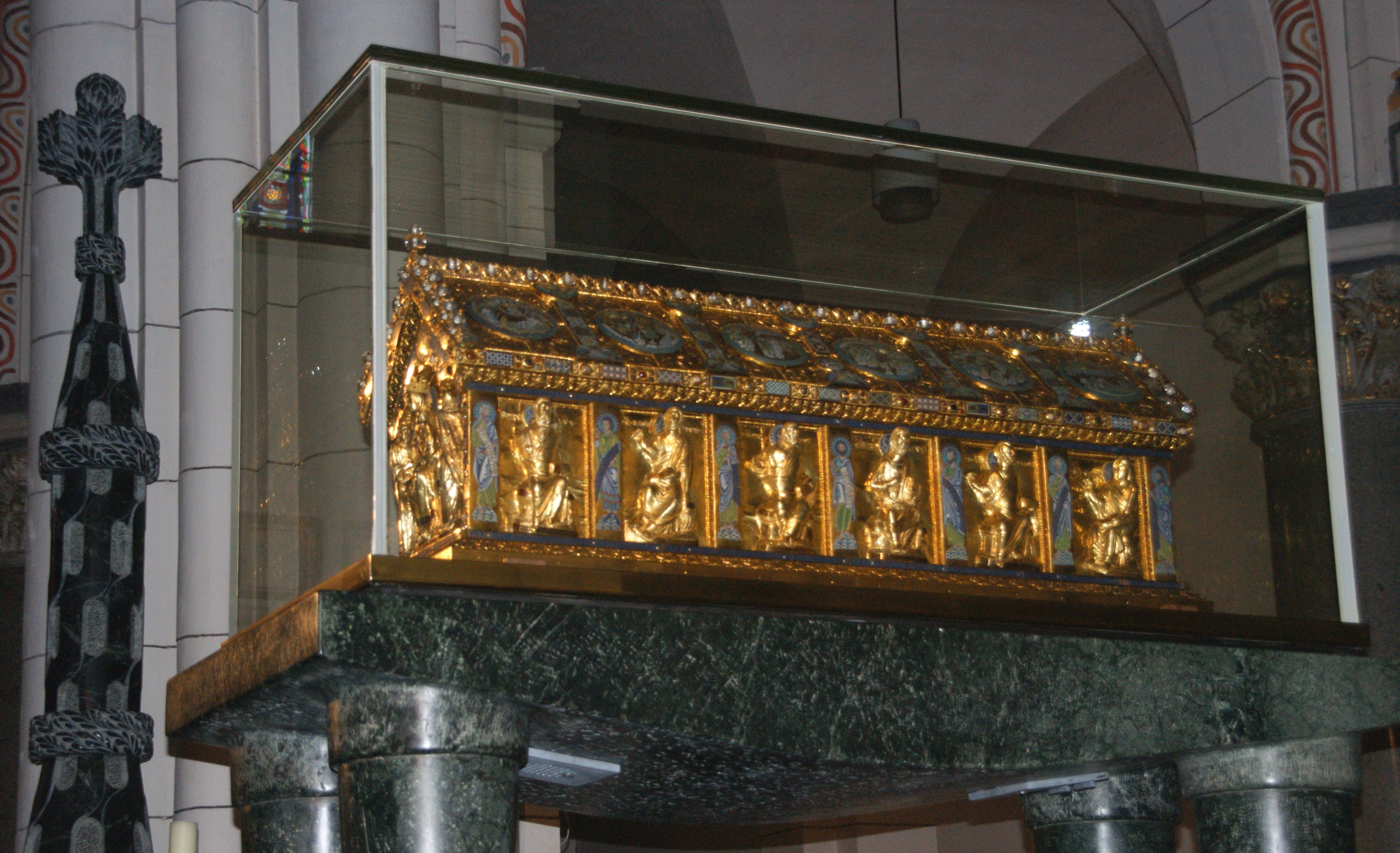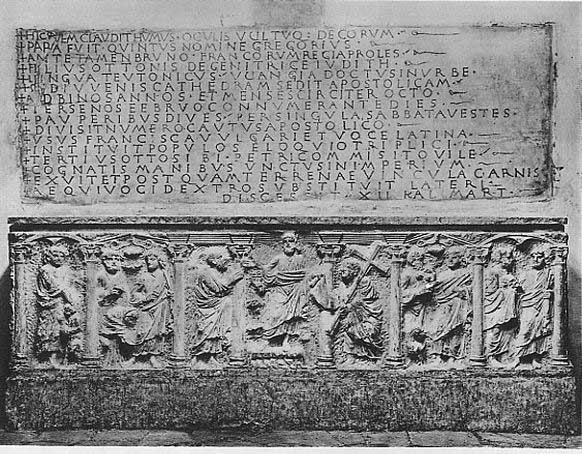|
Heribert Of Cologne
Heribert of Cologne ( 970 – 16 March 1021), also known as Saint Heribert, was a German Roman Catholic prelate who served as the Archbishop of Cologne from 999 until his death. He also served as the Chancellor for the Emperor Otto III since 994. He also collaborated with Henry II, Holy Roman Emperor with whom relations were strained though were strengthened over time. Heribert's canonization was confirmed around 1075. Life Heribert was born around 970 in Worms to Count Hugo and Tietwista. On the maternal side his half-brother was Heinrich who was the Bishop of Würzburg. He was educated in the school at the Worms Cathedral and at the Benedictine Gorze convent in Lorraine. Heribert studied alongside Bruno of Carinthia who was the future Pope Gregory V. He wanted to become a Benedictine monk but his father disapproved of that path and Heribert no longer pursued it. He returned to the Worms Cathedral to serve as its provost and received his ordination to the priesthood ... [...More Info...] [...Related Items...] OR: [Wikipedia] [Google] [Baidu] |
Canonization
Canonization is the declaration of a deceased person as an officially recognized saint, specifically, the official act of a Christian communion declaring a person worthy of public veneration and entering their name in the canon catalogue of saints, or authorized list of that communion's recognized saints. Catholic Church Canonization is a papal declaration that the Catholic faithful may venerate a particular deceased member of the church. Popes began making such decrees in the tenth century. Up to that point, the local bishops governed the veneration of holy men and women within their own dioceses; and there may have been, for any particular saint, no formal decree at all. In subsequent centuries, the procedures became increasingly regularized and the Popes began restricting to themselves the right to declare someone a Catholic saint. In contemporary usage, the term is understood to refer to the act by which any Christian church declares that a person who has died is a sa ... [...More Info...] [...Related Items...] OR: [Wikipedia] [Google] [Baidu] |
Henry II, Holy Roman Emperor
Henry II (german: Heinrich II; it, Enrico II; 6 May 973 – 13 July 1024), also known as Saint Henry the Exuberant, Obl. S. B., was Holy Roman Emperor ("Romanorum Imperator") from 1014. He died without an heir in 1024, and was the last ruler of the Ottonian line. As Duke of Bavaria, appointed in 995, Henry became King of the Romans ("Rex Romanorum") following the sudden death of his second cousin, Emperor Otto III in 1002, was made King of Italy ("Rex Italiae") in 1004, and crowned emperor by Pope Benedict VIII in 1014. The son of Henry II, Duke of Bavaria, and his wife Gisela of Burgundy, Emperor Henry II was a great-grandson of German king Henry the Fowler and a member of the Bavarian branch of the Ottonian dynasty. Since his father had rebelled against two previous emperors, the younger Henry spent long periods of time in exile, where he turned to Christianity at an early age, first finding refuge with the Bishop of Freising and later during his education at the c ... [...More Info...] [...Related Items...] OR: [Wikipedia] [Google] [Baidu] |
Rome
, established_title = Founded , established_date = 753 BC , founder = King Romulus ( legendary) , image_map = Map of comune of Rome (metropolitan city of Capital Rome, region Lazio, Italy).svg , map_caption = The territory of the ''comune'' (''Roma Capitale'', in red) inside the Metropolitan City of Rome (''Città Metropolitana di Roma'', in yellow). The white spot in the centre is Vatican City. , pushpin_map = Italy#Europe , pushpin_map_caption = Location within Italy##Location within Europe , pushpin_relief = yes , coordinates = , coor_pinpoint = , subdivision_type = Country , subdivision_name = Italy , subdivision_type2 = Region , subdivision_name2 = Lazio , subdivision_type3 = Metropolitan city , subdivision_name3 = Rome Capital , government_footnotes= , government_type = Strong Mayor–Council , leader_title2 = Legislature , leader_name2 = Capitoline Asse ... [...More Info...] [...Related Items...] OR: [Wikipedia] [Google] [Baidu] |
Bishop Of Worms
The Prince-Bishopric of Worms, was an ecclesiastical principality of the Holy Roman Empire. Located on both banks of the Rhine around Worms just north of the union of that river with the Neckar, it was largely surrounded by the Electorate of the Palatinate. Worms had been the seat of a bishop from Roman times. From the High Middle Ages on, the prince-bishops' secular jurisdiction no longer included the city of Worms, which was an Imperial Free City (the Free Imperial City of Worms) and which became officially Protestant during the Reformation. The prince-bishops however retained jurisdiction over the Cathedral of Worms inside the city. In 1795 Worms itself, as well as the entire territory of the prince-bishopric on the left bank of the Rhine, was occupied and annexed by France. In the wake of the territorial reorganizations that came with the German mediatization of 1802, the remaining territory of the bishopric, along with that of nearly all the other ecclesiastical principalit ... [...More Info...] [...Related Items...] OR: [Wikipedia] [Google] [Baidu] |
Ordination
Ordination is the process by which individuals are consecrated, that is, set apart and elevated from the laity class to the clergy, who are thus then authorized (usually by the denominational hierarchy composed of other clergy) to perform various religious rites and ceremonies. The process and ceremonies of ordination vary by religion and denomination. One who is in preparation for, or who is undergoing the process of ordination is sometimes called an ordinand. The liturgy used at an ordination is sometimes referred to as an ordination. Christianity Roman Catholic, Orthodox, Lutheran and Anglican churches In Roman Catholicism and Orthodoxy, ordination is one of the seven sacraments, variously called holy orders or '' cheirotonia'' ("Laying on of Hands"). Apostolic succession is considered an essential and necessary concept for ordination in the Catholic, Orthodox, High Church Lutheran, Moravian, and Anglican traditions, with the belief that all ordained clergy ar ... [...More Info...] [...Related Items...] OR: [Wikipedia] [Google] [Baidu] |
Provost (religion)
A provost is a senior official in a number of Christian Churches. Historical development The word ''praepositus'' (Latin: "set over", from ''praeponere'', "to place in front") was originally applied to any ecclesiastical ruler or dignitary. It was soon more specifically applied to the immediate subordinate to the abbot of a monastery, or to the superior of a single cell, and it was defined as such in the Rule of St Benedict. The dean (''decanus'') was a similarly ranked official. Chrodegang of Metz adopted this usage from the Benedictines when he introduced the monastic organization of canon-law colleges, especially cathedral capitular colleges. The provostship (''praepositura'') was normally held by the archdeacon, while the office of dean was held by the archpriest. In many colleges, the temporal duties of the archdeacons made it impossible for them to fulfil those of the provostship, and the headship of the chapter thus fell to the dean. The title became ''prevost' ... [...More Info...] [...Related Items...] OR: [Wikipedia] [Google] [Baidu] |
Pope Gregory V
Pope Gregory V ( la, Gregorius V; c. 972 – 18 February 999), born Bruno of Carinthia, was the bishop of Rome and ruler of the Papal States from 3 May 996 to his death. A member of the Salian dynasty, he was made pope by his cousin, Emperor Otto III. Family Gregory was a son of Otto I, Duke of Carinthia, a member of the Salian dynasty who was a grandson of Holy Roman Emperor Otto I. Gregory V succeeded John XV as pope when only twenty-four years of age. He was the chaplain of his cousin, Otto III, who presented him as candidate. Gregory V is often counted as the first German pope (or the second if Boniface II, an Ostrogoth, is counted). Policies Politically, Gregory V acted consistently as the Emperor's representative in Rome and granted many exceptional privileges to monasteries within the Holy Roman Empire. One of his first acts was to crown Otto III emperor on 21 May 996. Together, they held a synod a few days after the coronation in which Arnulf, Archbishop of R ... [...More Info...] [...Related Items...] OR: [Wikipedia] [Google] [Baidu] |
Moselle
The Moselle ( , ; german: Mosel ; lb, Musel ) is a river that rises in the Vosges mountains and flows through north-eastern France and Luxembourg to western Germany. It is a left bank tributary of the Rhine, which it joins at Koblenz. A small part of Belgium is in its basin as it includes the Sauer and the Our. Its lower course "twists and turns its way between Trier and Koblenz along one of Germany's most beautiful river valleys."''Moselle: Holidays in one of Germany's most beautiful river valleys'' at www.romantic-germany.info. Retrieved 23 Jan 2016. In this section the land to the north is the Eifel which stretches into |
Gorze Abbey
Gorze Abbey was a Benedictine monastery in Gorze in the present arrondissement of Metz, near Metz in Lorraine. It was prominent as the source of a monastic reform movement in the 930s. History Gorze Abbey was founded in around 757 by Bishop Chrodegang of Metz, who obtained for it from Rome the relics of Saint Gorgonius. The new community at first followed his Rule, but decline later set in. The highly placed Frankish lord Bivin of Gorze (810–863), married to a daughter of Boso the Elder, functioned as lay abbot of Gorze. In 933 the premises, by then semi-derelict, were given by Adalbero, Bishop of Metz, to John of Gorze and Einald of Toul so that they could restore observance of the Rule of St. Benedict. They did so extremely successfully and the customary of Gorze soon spread to many other monasteries, [...More Info...] [...Related Items...] OR: [Wikipedia] [Google] [Baidu] |
Order Of Saint Benedict
The Benedictines, officially the Order of Saint Benedict ( la, Ordo Sancti Benedicti, abbreviated as OSB), are a monastic religious order of the Catholic Church following the Rule of Saint Benedict. They are also sometimes called the Black Monks, in reference to the colour of their religious habits. They were founded by Benedict of Nursia, a 6th-century monk who laid the foundations of Benedictine monasticism through the formulation of his Rule of Saint Benedict. Despite being called an order, the Benedictines do not operate under a single hierarchy but are instead organised as a collection of autonomous monasteries. The order is represented internationally by the Benedictine Confederation, an organisation set up in 1893 to represent the order's shared interests. They do not have a superior general or motherhouse with universal jurisdiction, but elect an Abbot Primate to represent themselves to the Vatican and to the world. Historical development The monastery at S ... [...More Info...] [...Related Items...] OR: [Wikipedia] [Google] [Baidu] |
Worms Cathedral
St Peter's Cathedral (German: ''Wormser Dom'') is a Roman Catholic church and former cathedral in Worms, southern Germany. The cathedral is located on the highest point of the inner city of Worms and is the most important building of the Romanesque style in Worms. It is closely associated with Bishop Burchard and the high point of Worms' history in the 12th and 13th centuries. It was the seat of the Catholic Prince-Bishopric of Worms until its extinction in 1802, during German mediatisation. After the extinction of the bishopric, it was reduced in status to that of a parish church; however, it was bestowed the title of minor basilica in 1925 by Pope Pius XI. Most of the cathedral was finished by 1181, however the west choir and the vaulting were built in the 13th century, the elaborate south portal was added in the 14th century, and the central dome has been rebuilt. Great events associated with the cathedral include the nomination of Leo IX as Pope in 1048, the Conco ... [...More Info...] [...Related Items...] OR: [Wikipedia] [Google] [Baidu] |


.jpg)




